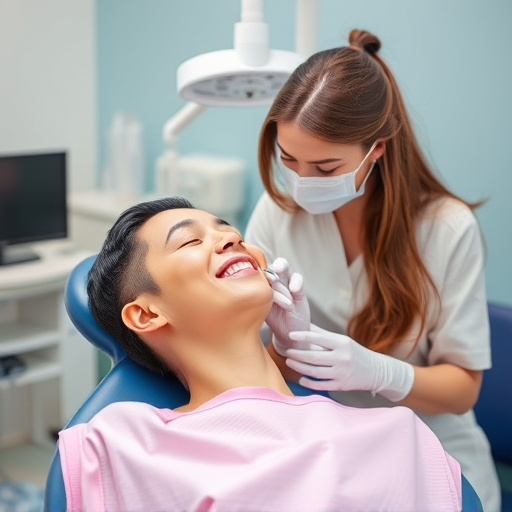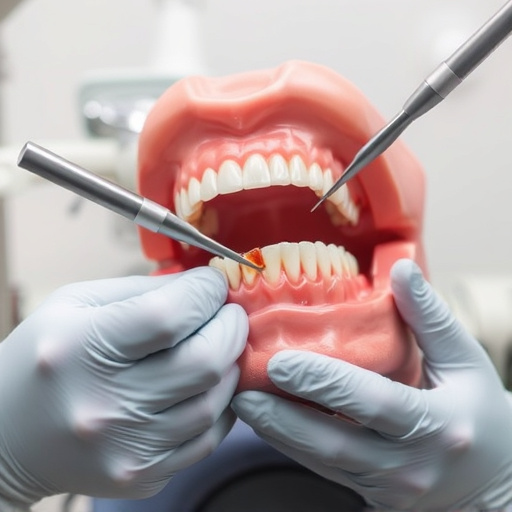Handicap Accessible Dental Care: Inclusive Environments with Top Follow-Up
Handicap accessible dental offices are designed to provide equal access to oral healthcare services…….
In a world where accessibility is a fundamental human right, the concept of Handicap Accessible Dental (HAD) emerges as a transformative force in the oral healthcare sector. This comprehensive approach ensures that individuals with disabilities or physical challenges have equal access to dental care services, promoting overall health and well-being. The article delves into the multifaceted world of HAD, exploring its definition, global impact, economic implications, technological innovations, policy frameworks, and future prospects. By shedding light on these aspects, we aim to educate readers about the critical role this initiative plays in shaping a more inclusive healthcare landscape.
Definition: Handicap Accessible Dental refers to a set of practices, policies, and physical modifications designed to make dental care services fully accessible and usable by people with physical disabilities or impairments. It involves adapting both the dental clinic environment and procedures to cater to diverse patient needs, ensuring comfort, safety, and effectiveness throughout the treatment process.
Core Components:
Historical Context:
The push for handicap accessibility in dental care gained momentum in the late 20th century as societies became increasingly aware of the rights and needs of individuals with disabilities. International organizations, such as the United Nations (UN), played a pivotal role by adopting policies promoting accessibility across various sectors, including healthcare. The UN’s Convention on the Rights of Persons with Disabilities (CRPD), signed in 2006, explicitly addresses accessibility, setting a global standard for countries to follow and influencing dental care practices worldwide.
Handicap Accessible Dental has a profound global impact, shaping healthcare systems and policies worldwide. According to the World Health Organization (WHO), approximately 1 billion people live with some form of disability, highlighting the urgent need for accessible healthcare services, including dentistry. Here’s an overview of its influence:
International Adoption: Many countries have embraced the principles of HAD, incorporating them into national healthcare strategies. For instance, the European Union (EU) has implemented directives ensuring accessibility across various sectors, including dental care, while many member states have further solidified these standards in their national laws.
Regional Variations: The level of adoption and implementation varies across regions. Developed countries tend to have more robust frameworks due to advanced healthcare systems and increased awareness. In contrast, developing nations often face challenges related to resource allocation and infrastructure, but they are making strides toward accessibility through targeted initiatives and partnerships.
Case Studies: Countries like Australia and New Zealand stand out for their comprehensive approaches, featuring specialized dental clinics tailored to the needs of patients with disabilities. These facilities offer a model for other countries to emulate, showcasing the positive impact of dedicated resources.
The economic landscape surrounding Handicap Accessible Dental is complex, involving multiple stakeholders and market dynamics:
Market Opportunity: The global dental care market is substantial, estimated at over $450 billion in 2021, with a growing focus on accessibility. This presents an opportunity for dental service providers to cater to underserved populations, including individuals with disabilities, thereby expanding their customer base and revenue streams.
Investment Patterns: Governments and private investors are increasingly recognizing the importance of HAD, leading to increased funding for accessible dental facilities and research. For instance, the US government has allocated funds through initiatives like the Health Resources and Services Administration (HRSA) to improve access to dental care for people with disabilities.
Cost Analysis: Implementing HAD measures can vary in cost, from minor renovations to significant investments in specialized equipment. However, studies suggest that these costs are offset by improved patient satisfaction, reduced no-show rates, and long-term health benefits, making it a financially viable investment.
Technology plays a pivotal role in shaping the future of Handicap Accessible Dental, offering innovative solutions to longstanding challenges:
Teledentistry: Remote dental care through teleconferencing enables individuals with disabilities to access dental professionals from the comfort of their homes. This technology is particularly beneficial for those with limited mobility, addressing accessibility gaps, especially in rural or underserved areas.
3D Imaging and Printing: Advanced imaging techniques and 3D printing technology are revolutionizing dental prosthetics and surgeries. These tools enable precise customization, improving outcomes for patients with unique anatomical needs or complex medical histories.
Smart Dental Devices: The development of smart dental instruments equipped with sensors and connectivity features enhances precision and safety during procedures. These devices provide real-time data, allowing dental professionals to make informed decisions and adapt treatments accordingly.
Virtual Reality (VR) for Pain Management: VR technology offers a non-pharmacological approach to managing dental anxiety and pain. By creating immersive environments, patients can distract themselves from the procedure, leading to improved comfort and cooperation during treatment.
Policy frameworks and regulatory bodies play a crucial role in driving the adoption and standardization of Handicap Accessible Dental:
International Guidelines: Organizations like the WHO provide guidelines and recommendations for accessible healthcare, including dental care. These guidelines offer a global reference point, ensuring consistent standards across countries.
National Legislation: Many countries have enacted laws mandating accessibility in various sectors, with specific provisions for healthcare facilities. For example, the Americans with Disabilities Act (ADA) in the United States guarantees equal access to services, including dental care, for individuals with disabilities.
Professional Associations: Dental associations worldwide are actively involved in promoting HAD through advocacy, education, and setting standards. They provide resources, guidelines, and training programs to support dental professionals in delivering accessible care.
Quality Assurance Programs: Some countries have implemented quality assurance programs specifically for dental care, focusing on accessibility as a core component. These programs ensure that dental practices maintain high standards of accessibility, safety, and patient-centered care.
Despite its numerous advantages, Handicap Accessible Dental faces several challenges and criticisms:
Resource Allocation: One of the primary hurdles is securing adequate funding for implementing accessibility modifications in existing facilities or designing dedicated accessible clinics. This challenge is particularly acute in regions with limited financial resources.
Lack of Training: Dental professionals may require specialized training to address the unique needs of patients with disabilities. Ensuring widespread access to such training programs can be challenging but is essential for effective HAD delivery.
Standardization and Consistency: Developing uniform standards and guidelines for HAD globally is complex due to varying healthcare systems and cultural contexts. Standardization ensures consistency in care quality, which is crucial for patients’ trust and satisfaction.
Criticism from Some Quarters: Some critics argue that the focus on accessibility might compromise dental treatment outcomes or increase costs unnecessarily. However, well-designed HAD initiatives aim to strike a balance between accessibility and clinical effectiveness, addressing these concerns.
Case Study 1: Australia’s Dedicated Dental Centers
Australia has made significant strides in HAD through the establishment of dedicated dental centers tailored for patients with disabilities. The National Disability Insurance Scheme (NDIS) supports individuals with disability-related costs, including dental care. These centers offer a comprehensive range of services, from routine check-ups to complex surgeries, all designed to accommodate diverse patient needs. The success of these facilities lies in their specialized staff, adapted equipment, and patient-centered approach, leading to improved oral health outcomes for this population.
Case Study 2: Teledentistry in Rural India
In rural areas with limited dental professionals, teledentistry has emerged as a game-changer. Non-profit organizations in India have implemented mobile dental clinics equipped with teleconferencing capabilities, allowing dental experts to provide consultations and guidance to remote communities. This approach addresses the accessibility gap, ensuring that individuals with disabilities or those living in underserved regions can access dental care despite geographical barriers.
Case Study 3: The Netherlands’ Integrated Care Model
The Netherlands has pioneered an integrated care model for patients with complex healthcare needs, including dental care. This collaborative approach involves general dentists, specialists, and other healthcare professionals working together to provide comprehensive services. By combining expertise, this model ensures that patients with disabilities receive coordinated, accessible care, improving overall health outcomes and patient satisfaction.
The future of Handicap Accessible Dental is filled with promising trends and opportunities for strategic growth:
Data-Driven Decision Making: The use of data analytics can help identify accessibility gaps and inform service delivery strategies. By analyzing patient demographics, preferences, and outcomes, dental practices can tailor their services to meet the specific needs of diverse populations.
Personalized Medicine: Advancements in biotechnology and genomics enable personalized dental care, taking into account individual genetic factors. This approach may lead to improved treatment outcomes, especially for patients with unique medical conditions or disabilities.
Global Collaboration: International partnerships can foster knowledge sharing, resource pooling, and best practice implementation. Collaborative efforts can address challenges related to standardization and accessibility on a global scale, ensuring that people with disabilities worldwide have access to quality dental care.
Integration with Digital Health: The integration of HAD with digital health technologies, such as mobile apps and wearable devices, offers new opportunities for remote monitoring, patient education, and personalized care. These tools can empower individuals with disabilities to take a more active role in managing their oral health.
Handicap Accessible Dental represents a significant step forward in ensuring equitable access to oral healthcare, catering to the diverse needs of individuals worldwide. By addressing physical, sensory, and communication barriers, this initiative promotes inclusivity, improves patient satisfaction, and enhances overall health outcomes. As technological advancements continue to shape the dental landscape, HAD will play an increasingly critical role in serving all members of society.
Q: How do I know if my local dental clinic is handicap accessible?
A: Look for signs or ask the practice directly about their accessibility features. They should be able to provide information on wheelchair access, specialized equipment, and communication support.
Q: Are there financial assistance programs for individuals with disabilities seeking dental care?
A: Yes, many countries have initiatives like Medicaid (US), NHS (UK), or NDIS (Australia) that offer financial support for dental care, including HAD services. Contact your local healthcare authority to inquire about eligibility and available benefits.
Q: What role do dental associations play in promoting handicap accessible dental?
A: Dental associations worldwide advocate for HAD through policy development, education, and training programs. They provide resources and guidelines to help professionals deliver accessible care while pushing for favorable policies and regulations.
Q: Can technology truly revolutionize dental care for individuals with disabilities?
A: Absolutely! Technological advancements offer innovative solutions, from teledentistry to smart dental devices, improving accessibility and patient experiences. These tools enable remote consultations, personalized treatments, and enhanced safety during procedures.
Q: How can I contribute to the improvement of handicap accessible dental in my community?
A: You can get involved by supporting local initiatives, volunteering at specialized dental clinics, or advocating for HAD through community organizations and professional networks. Awareness and active participation drive positive change in accessibility standards and service availability.

Handicap accessible dental offices are designed to provide equal access to oral healthcare services…….

Ensuring dental care accessibility for individuals with disabilities is crucial for inclusive health…….

Handicap accessible dental clinics are crucial for providing equal oral healthcare, removing physica…….